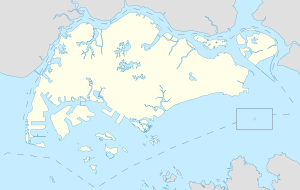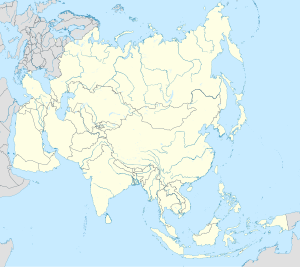Seletar Airport
01°25′08.4″N 103°51′57.0″E / 1.419000°N 103.865833°E
Seletar Airport Lapangan Terbang Seletar ( AMSL | 11 m / 36 ft | ||||||||||
|---|---|---|---|---|---|---|---|---|---|---|---|
| Coordinates | 01°25′01″N 103°52′04″E / 1.41694°N 103.86778°E | ||||||||||
| Website | www | ||||||||||
| Map | |||||||||||
| Runways | |||||||||||
| |||||||||||
Seletar Airport (IATA: XSP, ICAO: WSSL) is a civilian international airport serving the north-east region of Singapore. It is located approximately 16 kilometres (9.9 mi) northwest from Changi Airport, the country's main airport, and about 16 kilometres (9.9 mi) north from the main commercial city-centre.
The airfield was originally opened in 1928 as RAF Seletar, a military airbase of the British Royal Air Force (RAF). The base was handed back over to Singapore in 1971. The Government of Singapore intended for Seletar Airport and the surrounding areas to function as the operating aerodrome for their plan to expand Singapore's status as an industrial aviation hub, today known as the Seletar Aerospace Park.[1]
Today, Seletar Airport mostly serves
History
RAF Seletar

RAF Seletar was a Royal Air Force station in Singapore between 1928 and 1971. Plans for establishing an airfield, flying boat and naval base in Singapore were first agreed by the RAF in 1921. In 1923, two sites in the northern region of the island were approved. The first planes to arrive at the base were four Supermarine Southampton seaplanes on 28 February 1928.
RAF Seletar was also used for civilian flights from 1930 to 1937, when Kallang Airport was opened.
World War II
With the threat of war in the area, the RAF started building up their forces in the Far East in the late 1930s and early 1940s. Seletar airfield was the target of
When the Japanese launched their invasion of
21 Squadron, Royal Australian Air Force was also based at Seletar in 1941–42, and was in the process of converting from lightly-armed CAC Wirraway trainers to Brewster F2A Buffalo fighters, when hostilities began.
These units stayed until Jan–Feb 1942, soon before the surrender to the invading Japanese.[4]
During the Japanese occupation, Seletar as was in the case of
Post-World War II

After World War II, the base went back to the RAF and, in the late 1940s and 1950s, the base was heavily involved in the
During the 1960s, RAF Seletar was home base to No's
In December 1966, three Andover CC Mk1 arrived to replace the ageing Vickers Valetta C1 aircraft of 52 Sqn. 52 Squadron was later reformed in March 1967 after the arrival of a further three aircraft. By now, Confrontation had finished and with no purpose the squadron moved to Changi in 1968 before being disbanded in January 1970.[5]
The RAF station closed at the end of March 1971 (see East of Suez) and Seletar was handed over to Singapore's Department of Civil Aviation.[6]
Several aircraft types flew their last RAF operational sorties from Seletar including the Short Singapore flying boat (Mk.III K6912 of No. 205 Squadron RAF 14 October 1941, aircraft transferred to No. 5 Squadron RNZAF),[7] Supermarine Spitfire (PR.XIX PS888 of 81 Sqn 1954), De Havilland Mosquito (PR.34 RG314 of 81 Sqn 1955), Short Sunderland flying boat (GR.5 ML797 "P" of 205 Sqn, 15 May 1959) and Bristol Beaufighter (TT.X RD761 Station Flight 1960). The Short Sunderland flying boats started in RAF service from Seletar on 22 June 1938 with 230 Sqn,[8] a sister squadron of 205 Sqn.
Seletar Airbase
The formative years of the SADC (later the RSAF) was established at Seletar Airbase in September 1968, with the setting up of the Flying Training School (FTS) utilising three Cessna 172G/H on loan from the Singapore Flying Club. The subsequent arrival of eight new Cessna 172Ks in May 1969, took over the duty from the former and contributed to the increase of training tempo for more selected trainees to participate in the basic flight-training course.
On 29 October 1977, four armed Vietnamese hijacked a domestics Air Vietnam flight from Saigon, Vietnam to Phu Quoc island west of Saigon, and forced the aircraft, a Douglas DC-3, to land at Seletar Airport.[6][9] The hijackers killed two Vietnamese crew members and seriously wounded a third.[9] The hijackers were seeking political asylum in Singapore and eventually surrendered themselves to Singapore authorities.[9]
Changi Airport Group management
As part of the Seletar Aerospace Park programme, the runway was extended to 1,840 metres in 2011 to enable larger and heavier aircraft to use the airport.[11] The airport's avionics systems were also upgraded.[12]
The airport underwent refurbishment in 2015 as part of plans to relieve pressure on Changi Airport by increasing Seletar Airport's capacity and move smaller and slower aircraft from Changi to Seletar airport.[13]
A new passenger terminal building opened on 19 November 2018, replacing the previous passenger terminal.[14] The terminal houses four check-in counters, six immigration lanes, two security screening stations and a gate holdroom that can accommodate 200 passengers.[15][16][17]
Instrument Landing System (ILS) usage
In 2018, the use of the
Current operations
Seletar Airport now operates as a general aviation airport, mainly for chartered flights, private aircraft operations and training purposes. The airport is currently open for arrivals and departures from 07:00 LCL until 22:00 LCL. It has a single runway with 27 aircraft stands, 100 square metres of warehouse space and can handle 840 tons of freight per day. In 1998, the airport recorded receiving a total of 7,945 scheduled flights, handled 23,919 passengers and 6,025 tons of cargo. The airport fire service, AES Seletar, is provided by Changi Airport Group. AES Seletar has 1 station housing 6 apparatus (water tender, foam tender and others) and provides Level 7 protection.[20]
The Republic of Singapore Flying Club and
Previously,
Due to the COVID-19 pandemic, the number of daily commercial flight operations at the airport have severely declined. Airport operations are also subjected to new processes and rules laid down by the Singapore government Ministry of Health and according to the Infectious Diseases Act.[23][24] On 13 June 2022, Firefly marked the resumption of flights to the airport since the suspension of commercial flights due to the pandemic.[25]
Airlines and destinations
Passenger
| Airlines | Destinations |
|---|---|
| Firefly | Kuala Lumpur–Subang[26][27] |
Photo gallery
-
Vickers Vildebeest Mk IIs, K2918 and K2921, of 'A' Flight, No. 100 (TB) Squadron, at RAF Seletar.
-
Short Singapore Mk III flying boat of 205 Sqn, in flight below three 'vic' formations of Vickers Vildebeest torpedo bombers of 100 Sqn.
-
A Short Singapore Mk III flying boat, similar to those operated by 205 Sqn.
-
Catalina I of 205 Sqn undergoing servicing in their hangar at RAF Seletar. One of the squadron's Short Singapore Mk III biplane flying boats can be seen in the right background.
-
December 1945, captured Mitsubishi J2M Raiden fighters belonging to the 381st Kōkūtai of Imperial Japanese Navy Air Service being evaluated at Seletar airfield.
-
The same Mitsubishi J2M Raiden fighters being test flown by Japanese naval aviators under close supervision of RAF officers from Seletar.
-
A 205 Sqn Short Sunderland Mark V ML797 "P" at the ramp of RAF Seletar, this particular airframe became the last of its type to retire from active RAF service on 30 June 1959.
-
ASpitfire PR Mk 19, similar to those operated by No. 81 Squadron RAFfrom RAF Seletar.
-
The viewing gallery ofPiper Warrior taxiingon the runway.
-
Seletar Flying Club's Cessna 172 9V-BOQ during preflight preparation for night operations.
Ground transportation
Bus
Two bus services (services 103 and 117) are available from the old airport terminal.
Since 14 October 2018, Service 102
Passengers heading to Changi Airport can alight at Jalan Kayu roundabout and transfer to 858. Connections to Tampines, Pasir Ris & Serangoon via services 168, 39 and 103 are also possible here.
Rail
While there are currently no
Taxi
Taxis are available at the
Private transportation
All pick-ups by private transportation occur at the arrival pick-up point.[30]
See also
- Singapore strategy
- British Far East Command
- Far East Air Force (Royal Air Force)
- Far East Strategic Reserve
- Former overseas RAF bases
- Battle of Singapore
- Seletar Aerospace Park
- Woodbridge Hospital
- Singapore Changi Airport
References
- ^ "JTC | Seletar Aerospace Park". www.jtc.gov.sg. Retrieved 19 June 2021.
- ^ Hardiman, Jake (1 February 2022). "Seletar: Singapore's Often Forgotten Second Airport". Simple Flying. Retrieved 14 June 2022.
- ^ "wp-AMDT-2021-03" (PDF).
- ^ Shores et al. 1992, p. 146.
- ^ a b c d Jefford 2001, pp. 48–49.
- ^ a b "So long, old Seletar Airport". AsiaOne. 13 July 2015. Retrieved 1 April 2022.
- ^ "New Zealand Military Aircraft Serial Numbers – Short Singapore Mk III". adf-serials.com.
- ^ Rawlings 1969, p. 242.
- ^ a b c "Hijackers Take Vietnamese Plane, Kill 2". The Washington Post.
- ^ "Our Story". Changiairportgroup.com.sg. Archived from the original on 26 November 2015. Retrieved 3 March 2017.
- ^ "Extension of Seletar Airport runway completed". Civil Aviation Authority of Singapore. Government of Singapore. 14 September 2011. Retrieved 3 December 2019.
- ^ Karamjit Kaur (27 June 2007). "Seletar gets ready for makeover as aerospace hub". The Straits Times.
- ^ "Expansion Plans for Singapore Airport". Airliner World: 14. February 2015.
- ^ "Seletar Airport commences operations at new passenger terminal". changiairport.com. Retrieved 19 November 2018.
- ^ "New Passenger Terminal Building to Be Constructed at Seletar Airport to Support Aviation Growth". Civil Aviation Authority of Singapore (CAAS). 19 May 2016.
- ^ "New Passenger Terminal Building To Be Constructed at Seletar Airport To Support Aviation Growth". Changi Airport Group. 19 May 2016.
- ^ "New passenger terminal building at Seletar Airport in the works". Channel NewsAsia. 19 May 2016.
- ^ Straits Times (4 December 2018). "MOT releases documents on consultations with Malaysia on proposed new flight paths over Seletar Airport". The Straits Times. Retrieved 23 December 2018.
- ^ "Singapore withdraws Seletar Airport ILS, Malaysia suspends Pasir Gudang restricted area". CNA. 4 April 2019. Retrieved 4 January 2022.
Both countries said in a joint statement that the agreement was made "in the spirit of bilateral cooperation".
- ^ "Our Expertise". Changiairportgroup.com. Retrieved 3 March 2017.
- ^ https://scuba-do.com/article/tioman-island-7-ways-get-singapore/#Ultimately_Can_I_Fly_to_Tioman_from_Singapore
- ^ https://www.ttgasia.com/2022/04/18/berjaya-air-connects-singapore-redang-with-new-service
- ^ "Infectious Diseases Act 1976 - Singapore Statutes Online". sso.agc.gov.sg. Retrieved 18 March 2022.
- ^ "ADVISORY ON COVID-19" (PDF).
- ^ Grace Yeoh (13 June 2022). "Seletar Airport reopens to first commercial flights since COVID-19". CNA. Retrieved 13 June 2022.
- ^ Ian Cheng (23 May 2022). "Low-cost Malaysian carrier Firefly Airlines to resume flights to Singapore from June". CNA.
- ^ "Malaysian carrier Firefly resumes flights to Singapore as first plane lands at Seletar Airport". CNA. Mediacorp. 21 April 2019. Archived from the original on 20 April 2022.
- ^ "TransitLink eGuide - Bus Service Information". www.transitlink.com.sg. Retrieved 19 June 2021.
- ^ "TransitLink eGuide - Bus Service Information". www.transitlink.com.sg. Retrieved 19 June 2021.
- ^ a b "Transport". Seletar Airport.
Works cited
- Wing Commander C. G. Jefford (2001). RAF Squadrons: A Comprehensive Record of the Movement and Equipment of All RAF Squadrons and Their Antecedents Since 1912. Shrewsbury, Shropshire, UK: Airlife Publishing, 1988. ISBN 978-1-84037-141-3.
- Rawlings, J.D.R. "History of 230 Squadron". Air Pictorial, July 1969. Vol. 31 No.7. pp. 242–244.
- Shores, Christopher, Brian Cull and Yasuho Izawa. Bloody Shambles: Volume One: The Drift to War to the Fall of Singapore. London: Grub Street, 1992. ISBN 0-948817-50-X.















